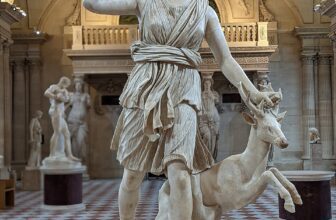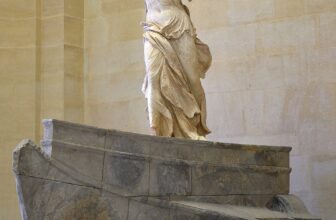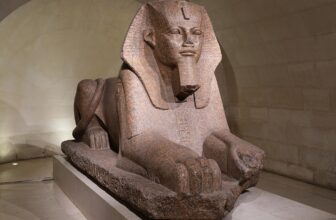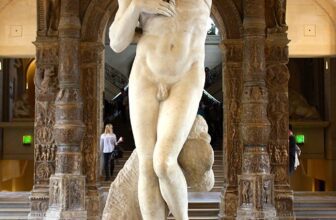
What are the most mysterious sculptures in the Louvre
The Louvre Museum in Paris, a treasure trove of artistic and historical marvels, is home to some of the world’s most enigmatic sculptures. Beyond their artistic brilliance, many of these sculptures carry with them unresolved mysteries, hidden histories, and unanswered questions that continue to perplex historians and art lovers alike. From missing pieces to debated origins, these sculptures evoke curiosity and wonder. Let’s take a journey through some of the most mysterious and intriguing sculptures housed in the Louvre.
1. The Venus de Milo: The Armless Wonder
One of the Louvre’s most celebrated sculptures, the Venus de Milo, remains a mystery in more ways than one. Discovered in 1820 on the Greek island of Milos, this stunning representation of Aphrodite (or possibly Amphitrite, the sea goddess) has captivated audiences with its ethereal beauty and enigmatic past. However, the biggest question remains: what happened to her arms?
There are many theories about how the arms were positioned before they went missing. Some suggest she was holding an apple, a nod to the Judgment of Paris, while others believe she held a mirror or draped cloth. Despite extensive studies, the true pose of Venus de Milo remains an enigma. Additionally, some scholars debate whether the sculpture was originally adorned with jewelry or painted in vibrant colors, as many ancient Greek sculptures were.
2. The Great Sphinx of Tanis: The Egyptian Guardian
Standing in the Louvre’s Egyptian antiquities section is the Great Sphinx of Tanis, a colossal sculpture carved from granite, dating back to around 2600 BCE. Unlike the famous Great Sphinx of Giza, this version, unearthed in the ruins of Tanis in Egypt, presents unique challenges to archaeologists and historians.
The mystery surrounding this sphinx lies in its inscriptions. It bears the cartouches (name rings) of multiple pharaohs, including Amenemhat II, Merneptah, and even Rameses II, suggesting that it was reused and re-inscribed over the centuries. Was it originally created for one ruler and then appropriated by others? What was its original purpose? These questions remain largely unanswered.
Additionally, the origins of the stone used to carve the Sphinx of Tanis remain disputed. Some experts believe the stone was transported from Aswan, a feat requiring extraordinary logistics in ancient times. The secrets behind its transportation, re-carving, and multiple inscriptions make this sculpture one of the Louvre’s most mysterious.
3. The Seated Scribe: The Watchful Eyes
The Seated Scribe, an ancient Egyptian sculpture dated to around 2600-2350 BCE, is one of the most lifelike and intriguing statues in the Louvre. Unlike many idealized representations of pharaohs and gods, this scribe is depicted with remarkable realism, his slightly plump body, attentive expression, and inlaid rock-crystal eyes that seem almost alive.
One of the biggest mysteries of the Seated Scribe is the identity of the person it represents. There are no inscriptions to indicate his name or his role beyond being a scribe. Was he an esteemed scholar or an advisor to the pharaoh? Furthermore, why was this statue preserved so well while many others from the same period suffered extensive damage? The realism and craftsmanship of this piece have led some to believe that it held special significance in ancient Egyptian society, but the answers remain elusive.
4. The Winged Victory of Samothrace: A Lost Triumph
The Winged Victory of Samothrace is a breathtaking sculpture that stands at the top of the Louvre’s grand staircase, depicting the Greek goddess Nike in triumphant motion. Discovered in 1863 on the island of Samothrace, it is one of the most revered sculptures of Hellenistic art. But many mysteries surround this iconic piece.
The biggest enigma is the missing head and arms. While historians have attempted reconstructions, the original pose and facial expression of Nike remain speculative. Additionally, experts debate whether the statue once held an object in her hands, a crown, a wreath, or even a weapon. Another unresolved question is where the rest of the monument is. The base was found separately, suggesting it was part of a larger naval victory dedication, but its full original structure is unknown.
Some theories also suggest the statue was meant to be viewed from a particular angle, adding an additional layer of mystery to its design and placement in antiquity. Despite these unanswered questions, the Winged Victory of Samothrace continues to inspire awe and admiration.
5. The Sleeping Hermaphroditus: An Optical Illusion of Beauty
A stunning and provocative sculpture, the Sleeping Hermaphroditus presents one of the most striking examples of ambiguity in art. At first glance, it appears to be a reclining female nude, but upon closer inspection, the viewer realizes that the figure possesses both male and female characteristics.
This Roman marble copy of a lost Greek original plays with perspective and expectation, making it one of the most enigmatic works in the Louvre. Its origins are debated, some believe it was created as part of a Dionysian cult, celebrating duality and transformation. The soft, sensuous pose of Hermaphroditus, combined with the element of surprise upon seeing the full form, has led many scholars to explore its deeper symbolic meanings.
Why was such a sculpture created? Was it meant for a private space, or was it displayed publicly in ancient Rome? These unanswered questions add to the allure and mystery of Sleeping Hermaphroditus.
6. The Bust of Akhenaten: The Pharaoh of Change
Pharaoh Akhenaten, known for his radical religious reforms and distinctive artistic depictions, remains one of ancient Egypt’s most enigmatic figures. The Bust of Akhenaten in the Louvre is a striking example of his unusual artistic style, featuring elongated facial features, full lips, and a nearly androgynous appearance.
The mystery surrounding this bust is twofold. First, why did Akhenaten choose to be depicted in such an unconventional way, breaking away from the traditional rigid, idealized form of Egyptian art? Second, after his reign, his successors attempted to erase him from history, destroying many of his statues and inscriptions. How did this particular bust survive? Was it hidden or protected by followers of his revolutionary monotheistic faith?
This sculpture raises more questions than it answers, making it one of the most intriguing pieces in the Louvre’s Egyptian collection.
A Museum of Mysteries
The Louvre is not just a repository of artistic masterpieces; it is a sanctuary of unresolved mysteries and historical puzzles. Each sculpture tells a story that extends beyond its form, inviting viewers to ponder the enigmas of lost civilizations, missing pieces, and hidden meanings.
From the missing arms of Venus de Milo to the unknown origins of the Great Sphinx of Tanis, the Louvre’s sculptures continue to bewitch and baffle art historians and visitors alike. These timeless works remind us that art is not just about beauty, it is also about the enduring mysteries of history, waiting to be unraveled by those who dare to look closer.




